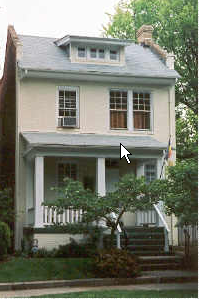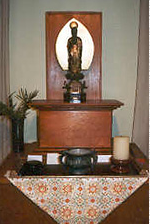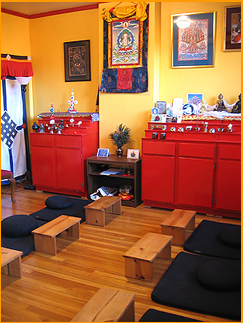Kagyu Shenpen Tharchin
![]() (Video of Buddhist icons and prayer)
(Video of Buddhist icons and prayer)
In 1986, Reverend Kenryu Tsuji, a Japanese-American Pure Land priest, founded the Ekoji Buddhist Sangha. The Sangha soon became home to other Buddhist groups, including a Vipassana and Zen group. In 1992, Bruce and Jean Drolmaf, Tibetan practitioners since the early 1980s, contacted their teacher, Lama Norhla Rinpoche about setting up a center of practice at the Ekoji Sangha. Lama Norlha Rinpoche, who is the abbot of Kagyu Thubten Choling Monastery and director of Kyabje Dorje Chang Kalu Rinpoche's Dharma centers in the eastern United States , consented. On January 19, 1993, the Tibetan group, now named Kagyu Shenpen Tharchin, had their first group practice.
 There is a two-hour practice every Thursday night in a room on the second floor of Ekoji. The first hour of the practice is dedicated to Chenrezi: the Lord of Compassion (also known as Avalokitesvara). In this hour, the group chants in Tibetan (some portions of the chants have English translations) and silently meditates on the goal of realizing their inborn great compassion. Implicit in this practice is the use of deity yoga, a practice unique to Tibetan Buddhism, in which the practitioner imagines oneself as being the deity of focus (for the Kagyu Shenpen Tharchin at Ekoji, the deity of focus is Chenrezi), and one meditates and acts as if one is the deity. For this reason, the Kagyu Shenpen Tharchin group focuses on realizing their inborn compassion, the primary trait of Chenrezi.
There is a two-hour practice every Thursday night in a room on the second floor of Ekoji. The first hour of the practice is dedicated to Chenrezi: the Lord of Compassion (also known as Avalokitesvara). In this hour, the group chants in Tibetan (some portions of the chants have English translations) and silently meditates on the goal of realizing their inborn great compassion. Implicit in this practice is the use of deity yoga, a practice unique to Tibetan Buddhism, in which the practitioner imagines oneself as being the deity of focus (for the Kagyu Shenpen Tharchin at Ekoji, the deity of focus is Chenrezi), and one meditates and acts as if one is the deity. For this reason, the Kagyu Shenpen Tharchin group focuses on realizing their inborn compassion, the primary trait of Chenrezi.
The final hour of practice consists of Dharma study and musical chanting. During the Dharma study, the practitioners read through a section of a text, sometimes sacred (like a sutra), and sometimes a little more modern (like the works of many monks and lamas). After a short reading the group discusses the main aspects read and how to apply it to their everyday lives. The session concludes with twenty to thirty minutes of meditative chanting set to the cadence of a few traditional Tibetan musical instruments. The primary purpose of this practice is to dispel the obstacles to spiritual practice, or in other words, it is a practice of cleansing before leaving the ritual space. The chants in this portion do not have any English translation, but the sound and the rhythm of the chants can stimulate a relaxed and meditative disposition.
 The major holidays celebrated by the Kagyu Shenpen Tharchin congregation are the Tibetan New Year and the Buddha's birthday. While there are many Buddhas, when referring to “the” Buddha, Buddhists are typically referring to Shakyamuni Buddha, the Buddha who attained enlightenment after meditating under a bodhi tree, the same Buddha who taught the Eightfold Path, the Four Noble Truths, and the Middle Way. Kagyu Shenpen Tharchin is a practice-only congregation, and the group does not engage in any community or outreach programs. The group does, however, participate in some of the programs run by the Ekoji Sangha, including a prison outreach program.
The major holidays celebrated by the Kagyu Shenpen Tharchin congregation are the Tibetan New Year and the Buddha's birthday. While there are many Buddhas, when referring to “the” Buddha, Buddhists are typically referring to Shakyamuni Buddha, the Buddha who attained enlightenment after meditating under a bodhi tree, the same Buddha who taught the Eightfold Path, the Four Noble Truths, and the Middle Way. Kagyu Shenpen Tharchin is a practice-only congregation, and the group does not engage in any community or outreach programs. The group does, however, participate in some of the programs run by the Ekoji Sangha, including a prison outreach program.
 There are approximately two hundred members who call the Ekoji Sangha their place of spiritual refuge, and between ten and fifteen of those members practice with the Kagyu Shenpen Tharchin. The Sangha has a piece of the actual bodhi tree under which the Buddha gained enlightenment framed by the front door. The Sangha also features regular visits from monks, nuns, and lamas from the various Buddhist traditions that practice at Ekoji.
There are approximately two hundred members who call the Ekoji Sangha their place of spiritual refuge, and between ten and fifteen of those members practice with the Kagyu Shenpen Tharchin. The Sangha has a piece of the actual bodhi tree under which the Buddha gained enlightenment framed by the front door. The Sangha also features regular visits from monks, nuns, and lamas from the various Buddhist traditions that practice at Ekoji.
Kagyu Shenpen Tharchin
Ekoji Buddhist Sangha
3411 Grove Avenue
Richmond , VA
(804)-272-4625
Profile prepared by Jon Headlee
December, 2007